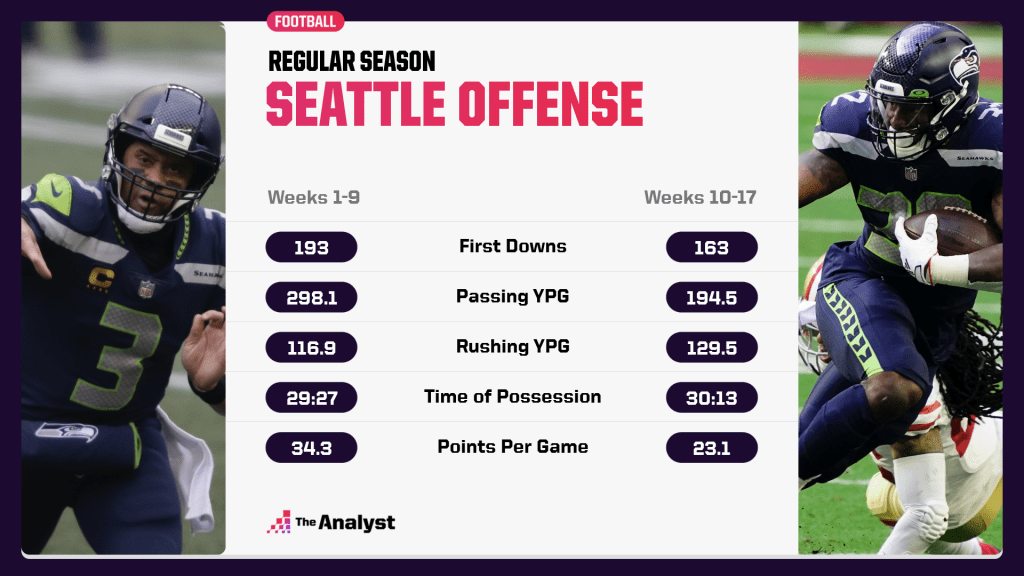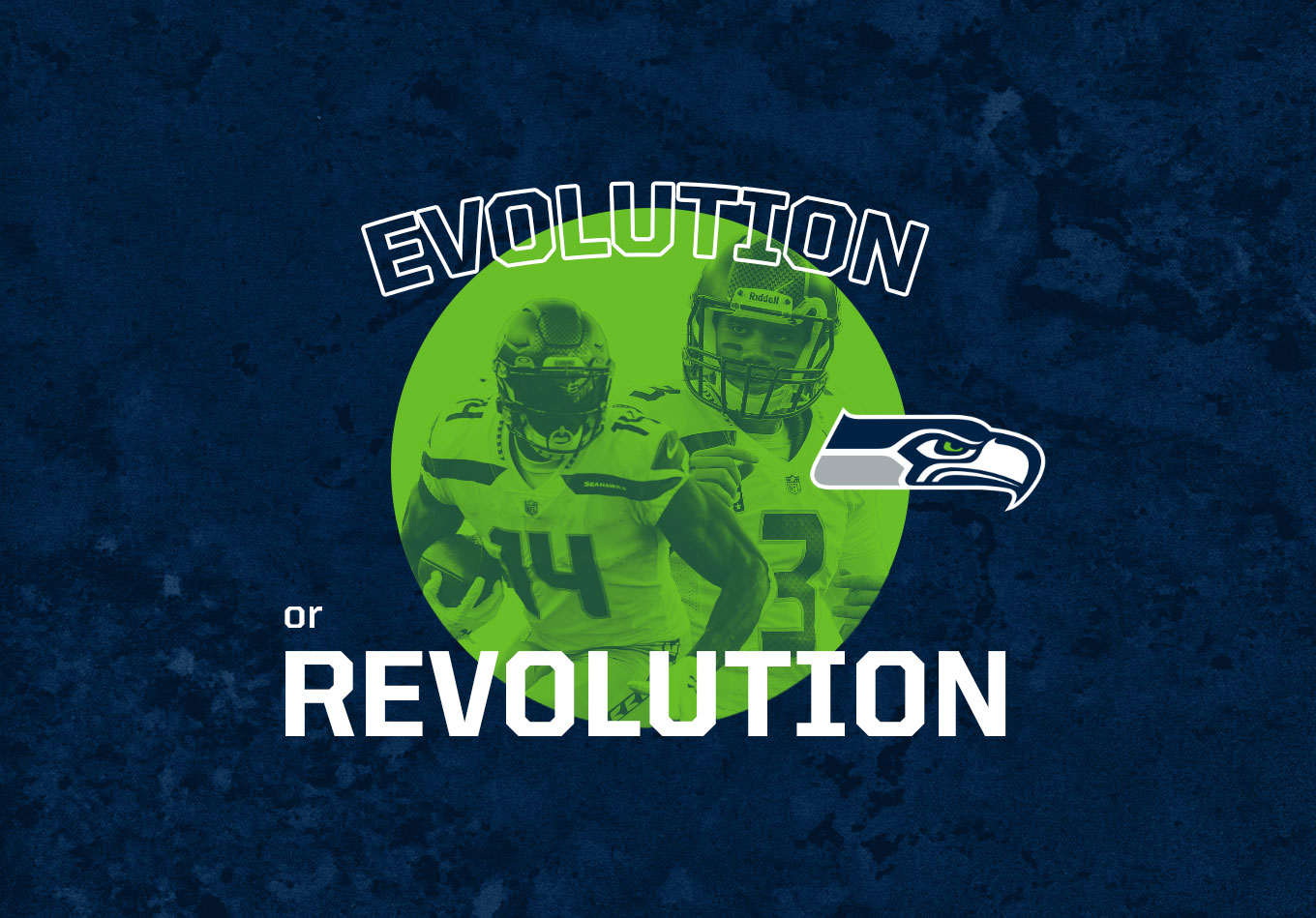Evolution or Revolution is a series that analyzes whether a team needs a few tweaks or a fundamental reboot.
The Seattle Seahawks’ wild-card round exit was a result that underlined the need for significant changes, but they decided not to head down a path nobody expected or would have advised.
Frustrated by the level of punishment he has taken behind an offensive line the Seahawks have failed to properly upgrade, quarterback Russell Wilson reportedly provided Seattle with a list of teams to whom he would accept a trade this offseason.
But it appears as though the Seahawks have opted to keep Wilson – for now – despite reports that the Chicago Bears had made a massive offer. It would have been a franchise-altering decision for a team that has consistently been in the playoff mix because of Wilson’s heroics.
So Wilson is still a Seahawk, but has Seattle done enough this offseason to ensure this same drama is not repeated next year?
We reflect on another year in which regular-season optimism gave way to postseason frustration and break down if the offseason moves the Seahawks have made will help them challenge for the Lombardi Trophy in 2021.
Offense
The Seahawks dispensed with the services of offensive coordinator Brian Schottenheimer following the playoff loss to the Los Angeles Rams, replacing him with former Rams assistant Shane Waldron.
It was a move that appeared unlikely early in the season when Seattle thrived after Schottenheimer and head coach Pete Carroll heeded the widespread calls to ‘let Russ cook.’ Yet there was an evident decline in the second half of the season. Of the 56 plays of 20 yards or more Seattle produced in 2020 – a disappointing 23rd in the NFL – only 20 of them came in the final eight games.
It is perhaps no coincidence that the drop-off came in the wake of a 44-34 defeat to the Buffalo Bills in Week 9 and a subsequent loss to the Rams. Wilson committed seven turnovers in those contests, sparking a change in approach from Carroll and a disagreement with his quarterback about how to fix the offense.
Carroll reverted to type, relying on the running game and the strength of a defense that made strides down the stretch as Seattle clinched the NFC West title.
From Weeks 1-9, only three teams registered fewer rushing attempts than the Seahawks’ 193. However, from Week 10 onwards they attempted the 12th-most rushes (218).
And the difference in the Seahawks’ performance on offense in those two timeframes could hardly be starker. Between Weeks 1-9, Seattle led the league with 434.5 scrimmage yards per game. In Weeks 10-17, they dropped to 24th with an average of 342.5.

Wilson’s statistics on deep throws also support the argument that letting him ‘cook’ is in Seattle’s best interests. Wilson led the NFL with 13 touchdowns on throws of 21 air yards or more among quarterbacks who attempted at least 25 of those last season.
Still, the Seahawks must do a better job in pass protection. Wilson’s percentage of sacks on pass plays was tied with Cam Newton for the ninth highest among QBs with at least 100 drop-backs.
The Seahawks sought to improve in this area by trading for Las Vegas Raiders guard Gabe Jackson, who is a much-needed replacement for the retiring Mike Iupati. Left tackle Duane Brown has been a positive, and he ranks 22nd in our projected offensive line rankings at 6.1% better than the league average. Our projected OL rankings are based on combined run block and pass protection data over the past three seasons.
They also re-signed Chris Carson and picked up tight end Gerald Everett from the Rams on a one-year, $6 million deal, but let Carlos Hyde and Phillip Dorsett walk in free agency.
Defense
Seattle’s big splash last year was to strike a blockbuster trade for All-Pro safety Jamal Adams, causing excitement and raising eyebrows at the same time.
The decision to trade two first-round picks to acquire Adams from the New York Jets was met with some skepticism. Even though he may fail to ever live up to that price tag, Adams did make a tangible impact on the defense in 2020.
He finished with 9.5 sacks, the most by a defensive back in a single season in NFL history, and provided a significant boost to a Seahawks’ pass rush that lacked dominant players up front. His efforts in that regard helped the Seahawks finish in the top 10 in opponent negative play yardage with 109 negative plays for minus-393 yards.
Seattle led the league in hurries (190), but didn’t finish many of its opportunities as it tied for sixth in knockdowns (104) and seventh in sacks (46). Making matters worse, the team was extremely susceptible to the passing game and allowed the seventh-most pass plays of 20 yards or more (55) in the NFL.
It likely won’t help that the Seahawks have replaced cornerback Shaquill Griffin with former San Francisco 49er Ahkello Witherspoon. Defensive end Kerry Hyder, who had 8.5 sacks for the 49ers last season, and Al Woods have been added to the defensive front.
The Seahawks were much better against the run, ranking fifth in the league by allowing only seven run plays of 20 yards or more. They didn’t give up a single touchdown run of that distance.
The Seahawks cannot rely on a safety to carry the pass-rushing load on a regular basis, and finding a dominant edge player who can convert on the pressure he creates should be top priority in the NFL draft. However, they don’t have a first-round pick because of the Adams trade.
Verdict: Evolution
Though it was almost ‘revolution’ had the Seahawks opted to deal Wilson, they’ve chosen to wait at least another year to do so.
General manager John Schneider has long been one of the best in the league at maneuvering up and down the draft board and the onus is on him to ensure the pass rush improves and that the Seahawks do a better job of keeping opposing pass rushes away from Wilson.
Should he fail to do so, Wilson’s dissatisfaction may lead to some franchise-changing consequences next offseason.
Taylor Bechtold contributed. Design by Matt Sisneros.
